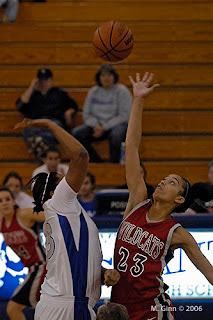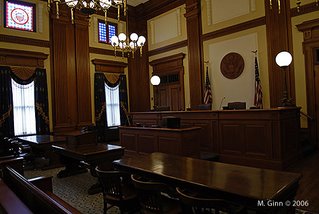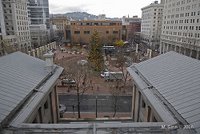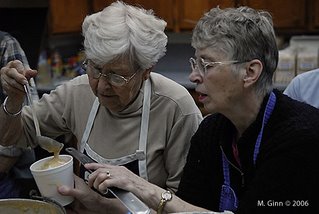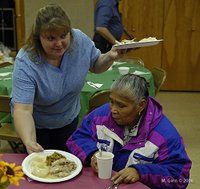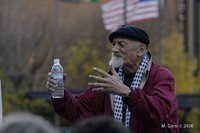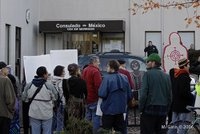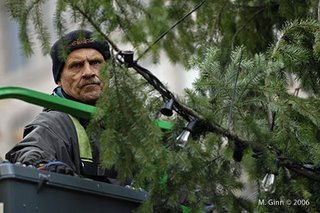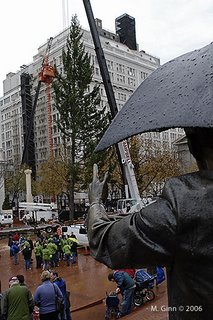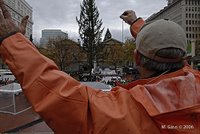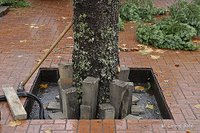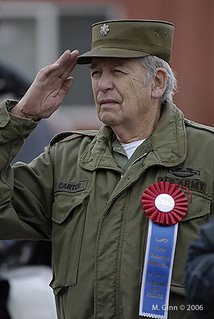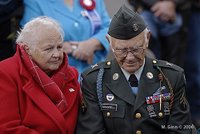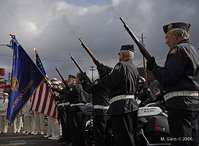 (above) "Todos somos Oaxaca! We are all Oaxaca!" chant protesters to conclude a skit performed in Holladay Park, near the Lloyd Center, in Portland, Ore., on Dec. 22, 2006. The protesters demonstrated in support of the people of Oaxaca, Mexico, where ongoing strikes have brought violent clashes with the police.
(above) "Todos somos Oaxaca! We are all Oaxaca!" chant protesters to conclude a skit performed in Holladay Park, near the Lloyd Center, in Portland, Ore., on Dec. 22, 2006. The protesters demonstrated in support of the people of Oaxaca, Mexico, where ongoing strikes have brought violent clashes with the police.
A group of about 60 gathered outside the Mexican Consulate in Portland, Ore., on Dec. 22, 2006, to support the ongoing people's uprising in Oaxaca, Mexico. A smaller group performed a skit dramatizing the Oaxaca story at the Lloyd Center MAX station later that afternoon. The demonstration in Portland was one of at least 15 held across the country on Friday.
In May, 2006, teachers in Oaxaca, Mexico, went on strike. It was not an unusual occurence, nor was it violent. The government rejected their demands, and on June 14 the police forcibly attempted to remove the strikers from the town square. Instead of ending the strike, though, the police action galvanized the teachers and prompted other groups to join them. A group called Asamblea Popular de los Pueblos de Oaxaca, or APPO (Popular Assembly of the Peoples of Oaxaca) emerged, representing teachers, students, farmers, and others in the working-class majority of Oaxaca. They occupied the plaza and several government buildings, took over several radio stations and at least one television station, and called for the resignation of the Governor of Oaxaca, Ulises Ruis Ortiz ("URO").
The police made additional attempts to remove the protesters, and violence ensued. APPO says that dozens of citizens have been arrested, raped and tortured, and at least nine have been killed.
Portland resident Kate Sherman was in Oaxaca for about 10 weeks this fall. While there was a lot of tension in the city when she arrived, it was when President Fox sent in the PFP (federal police) in October that things got out of hand.
"After that, the amount of gas, the amount of force that was used was just way out of proportion."
Mexico's new president, Felipe Calderon, pulled the PFP out of the city on Dec. 17, but they remain in the area. According to the New York Times, the arrest of several protest leaders has weakened the movement and reduced the frequency and size of demonstrations. State police have resumed responsibility for security in Oaxaca.
 John Brush (left) and Tim Ekeren portray a Mexican consular official and a TV personality, respectively, in a skit about Oaxaca performed by protesters in Holladay Park, near the Lloyd Center, in Portland, Ore., on Dec. 22, 2006.
John Brush (left) and Tim Ekeren portray a Mexican consular official and a TV personality, respectively, in a skit about Oaxaca performed by protesters in Holladay Park, near the Lloyd Center, in Portland, Ore., on Dec. 22, 2006.
It seems unlikely that the situation in Oaxaca would have lasted so long, become so violent or so widespread if it were simply a matter of teachers bargaining for a new contract. There are deep economic and political undertones influencing this year's events.
Oaxaca is one of the poorer parts of a nation that's poor by North American standards. The farmers say that they have been hurt badly by NAFTA, which allowed foreign ownership of once-public lands and an influx of subsidized American corn that they can't compete with. In the agriculture-based economy of the region, the impact has spread widely to the working class. They accuse NAFTA-supporter Ulises Ruiz Ortiz of winning the state gubernatorial election by fraud.
URO, says APPO, is just looking out for the interests of the rich landowners and tourism industry in Oaxaca. That is why he wants to remove the barricades that protesters have erected all over the city. The protesters, on the other hand, say that they need the barricades to prevent the police from attacking and arresting them.
Mexico's federal government appears to be concerned primarily with protecting law and order within the country. It seems that if a popular uprising in Oaxaca can overthrow the state's governor it might happen elsewhere, even at the federal level. Although European Union observers found no significant irregularities, left-wing groups in Mexico have accused President Felipe Calderon of "widespread fraud" in winning this summer's Presidential election.
 Kate Sherman speaks to protesters demonstrating in support of the people of Oaxaca, Mexico, in Portland, Ore., on Dec. 22, 2006. Sherman has been to Oaxaca six times over the last nine years. She returned to Portland less than two weeks ago after a 10-week trip to the area.
Kate Sherman speaks to protesters demonstrating in support of the people of Oaxaca, Mexico, in Portland, Ore., on Dec. 22, 2006. Sherman has been to Oaxaca six times over the last nine years. She returned to Portland less than two weeks ago after a 10-week trip to the area.
In Portland, activists have picketed the Mexican consulate several times this fall (see previous report on Oct. 31's rally). Kate Sherman, who has made repeated trips to Oaxaca over the past decade, says they are gathering to educate the public about the situation, network with each other, and "to let [the Mexican Government] know that the world is watching." She was a member of a delegation that met with the Consul on Friday afternoon.
Sherman, a Latin Studies student at Prescott College in Arizona, wants to return to Oaxaca.
"I definitely will go back some day," she says, "but ... [now] it's really dangerous there."
 Members of the Oregon State band and cheer team wait for their luggage at Portland International Airport on Dec. 30, 2006, after a charter flight from El Paso, Texas. On Dec. 29, OSU beat the University of Missouri 39-38 in the Sun Bowl.
Members of the Oregon State band and cheer team wait for their luggage at Portland International Airport on Dec. 30, 2006, after a charter flight from El Paso, Texas. On Dec. 29, OSU beat the University of Missouri 39-38 in the Sun Bowl. Band and cheer team members boarded buses in at 6:30 a.m. in El Paso to catch their flight back to Portland.
Band and cheer team members boarded buses in at 6:30 a.m. in El Paso to catch their flight back to Portland. Beavers fans returning from El Paso wore black and orange to honor their victorious team.
Beavers fans returning from El Paso wore black and orange to honor their victorious team.













